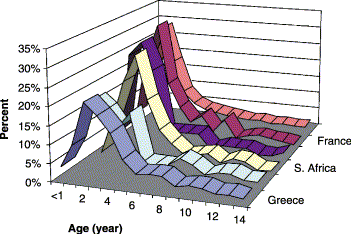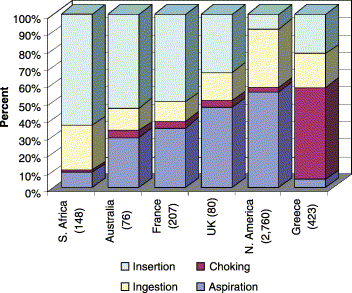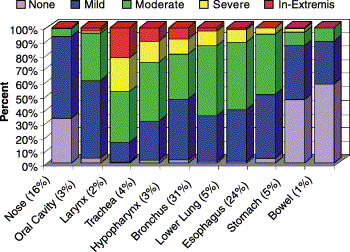Abstract
Background: To develop design criteria for consumer products, based on foreign body injury and fatality data, to prevent airway obstruction injuries to children. Method: Beginning in 1988, RAM Consulting has created a worldwide database of foreign body injuries. This ongoing project now includes approximately 7000 data points from 51 children's hospitals in 15 countries located in 5 continents. Statistical analysis of these data, especially in terms of size, shape, and consistency of the object and obstruction location and severity of injury for the patient has allowed the creation of an injury prevention criterion. Results: Analysis of these data reveals that adoption of an injury prevention criteria based on the use of a 1.50-in. (38.10-mm)-diameter gauge for nonspherical objects and a 1.75-in. (44.50-mm)-diameter gauge for spherical objects would greatly reduce airway obstruction injuries to children. Furthermore, the data show that this criterion is independent of country and culture. However, the data suggest that a child's exposure to the "mix" of objects that may cause airway obstruction varies with the country and culture of the child. For example, coins are well represented in the database; however, some countries make more coins than other countries, and the exposure level may have made the difference in the occurrence of incidents. Conclusions: Airway obstruction injuries from consumer products could be greatly decreased by the adoption of the presented injury prevention criteria that is founded in a statistical analysis of known objects that have caused injury. This criteria is dependent on object characteristics and is independent of the country or culture of the child.
E-mail address: [email protected]
Popular choices
- Casinos Not On Gamstop
- Casinos Not On Gamstop
- UK Betting Sites
- UK Online Casinos Not On Gamstop
- UK Online Casinos Not On Gamstop
- Non Gamstop Casinos UK
- Slots Not On Gamstop
- Sites Not On Gamstop
- UK Casino Not On Gamstop
- Non Gamstop Casinos
- UK Online Casinos Not On Gamstop
- UK Online Casinos Not On Gamstop
- UK Online Casinos Not On Gamstop
- Casinos Not On Gamstop
- Top UK Slot Sites
- Casinos Not On Gamstop
- Non Gamstop Casino Sites UK
- Sites Not On Gamstop
- Casino Sites UK Not On Gamstop
- Casinos Not On Gamstop
- Casino Sites Not On Gamstop
- UK Casinos Not On Gamstop
doi:10.1016/S0531-5131(03)01088-4
Click here for the PDF version
Contents
1. Introduction
Injury prevention criteria must be founded in a statistical analysis of data regarding objects that have caused injury. RAM Consulting, along with our partners in the medical community, have collected approximately 7000 data sets in a multi-institutional global study. A basic concept that must be understood is, "Should injury prevention criteria be based on an examination of the children or on the characteristics of the objects involved in injuries?" We will present findings that illustrate that an effective injury prevention criterion should be based on an analysis of the objects responsible.
The data analysis presented in this study may be used to construct a risk equation to determine the effect of object characteristics on the risk of injury. The probability of injury, or risk of injury, can be predicted by multiplying the "hazard" associated with an object by the "exposure" of the child to the object. The hazard of an object may be thought of as its potential to cause injury. For example, if an object is of a size, shape, and consistency to occlude the airway, it may be thought of as posing an airway obstruction hazard. Therefore, injury prevention can most effectively be accomplished through the adoption of a consumer product safety criterion that reduces the presence of objects of hazardous design in a child's environment.
2. Material and methods
Retrospective studies were cooperatively developed between RAM Consulting and a number of major children's hospitals globally [1, 2, 3]. In these studies, medical records were collected from Europe (n=1019), South Africa, and Israel (n=265), Australia and New Zealand (n=141), and Canada and the United States (n=5528).
The collected data for each case includes the size, shape, and consistency of the foreign objects. The data also include patient information such as age and gender, clinical data such as diagnoses technique, timeliness to diagnoses, foreign object location, method of removal, and injury severity level. The severity of the outcome was categorized as follows: none, mild, moderate, severe, and in-extremis. A brief description for each category is illustrated as follows:
- None (no injury), A brief event with no physical findings
- Mild injury, persistent coughing or other subtle symptoms
- Moderate injury, physical findings including abnormality of breathing functions
- Severe injury, emergency transport and medical intervention
- In-extremis injury, respiratory arrest, possible neurological damage
Written comments regarding child and caregiver behavior information were analyzed, where available, in order to learn how the injury event occurred.
The types of foreign body injuries have been divided into four separate categories, based on the anatomical location of the object within the child. These incident categories are aspiration, choking, ingestion, and insertion. They are defined in terms of location below.
- Aspiration: comprised of injuries from foreign objects that were removed from the trachea, bronchus, larynx, hypopharynx, and lower lung
- Choking: comprised of injuries from foreign objects that were removed from the oral cavity
- Ingestion: comprised of injuries from foreign objects that were removed from the esophagus, stomach, bowel, and rectum
- Insertion: comprised of injuries from foreign objects that were removed from the nose and nasopharynx
Length, width, and height measurements were used to evaluate the size of the object. The measurements were analyzed mathematically to determine the smallest diameter, or virtual ring, through which the object could pass.
3. Results
The age distribution was similar from one region to another. Globally, children under 3 were the most susceptible as illustrated in Fig. 1. They were involved in over half of the injuries, ranging from 53% in Greece to 79% in Australia.
Various foreign bodies were identified from the study. The majority of the foreign bodies were food (44%), metal (18%), plastic (15%), paper (2%), glass (2%), wood (2%), and textile (1%). The proportion of each material was different for each region. For example, paper products were involved in 11% of the injuries in France, but only 1% in North America.
Four types of incidents (namely, aspiration, choking, ingestion, and insertion) were separated in the study. The incident type was broken down for each region, as presented in Fig. 2.
Because children were exposed to different proportions of foreign bodies in different regions, the percentage of each incident type varied for each area. As illustrated in Fig. 2, choking incidents were associated with 53% of all foreign body injuries in Greece. This mainly resulted from the fact that fish bones were the leading foreign body in the Greece data, and 83% of these choking incidents involved fish bones. For all fish bone-related injuries in the Greek data, 99% of them were choking incidents.
Data from all sources were combined to study the likelihood of a foreign body becoming lodged in a certain body location and the corresponding severity outcome for that specific body location. Fig. 3 demonstrates the probability of severity for the primary body parts. The percentage in the parentheses next to each body part represents the likelihood of the injury occurrence, and the percentage on the y-axis stands for the probability of each severity outcome.
Not only was the likelihood of injury different for each body part, but also the severity outcome differed when controlled by body part. For example, even though only 2% of the injuries occurred in the larynx, 47% of them were either severe or in-extremis in nature. In contrast, the esophagus was associated with a much higher likelihood of injury occurrences (24%); however, the percentage of severe or in-extremis injuries was lower (5%).
The severity distribution differed depending on the anatomical area in which the foreign body lodged, and this difference in severity was consistent across the regions. For instance, the likelihood of severe or in-extremis injuries when a foreign body lodged in the larynx was 40% in non-North America regions and 48% for North America. Likewise, the likelihood of severe or in-extremis injuries when a foreign body lodged in the esophagus was 6% for non-North America areas and 6% for North America.
4. Discussion
Analysis indicates that there is no cultural or national difference in child–object interaction, although children from different cultures or regions may be exposed to a different "mix" of objects. These differences may be the result of variation in diet such as that seen in Greece, where greater fish consumption (exposure) leads to an increase in injuries caused by fish bones. Manufacturing technology variations may lead to an increase in exposure to certain materials, as may be seen in the greater number of injuries associated with plastic products in the United Kingdom and South Africa.
An examination of the size of the objects examined in this study clearly indicates that nonspherical objects equal to or less than 1.50 in. (38.10 mm) and spherical objects equal to or less than 1.75 in. (44.50 mm) pose a risk for airway obstruction injury to children. Injury prevention criteria for non-food manufactured objects to which children are exposed will be effective if based on these findings.
The incidence of airway obstruction injuries to children caused by poorly designed consumer products could be greatly reduced if a criterion based on the analysis of injury and fatality data presented in this paper were adopted for use in both the design and regulation of such products.




